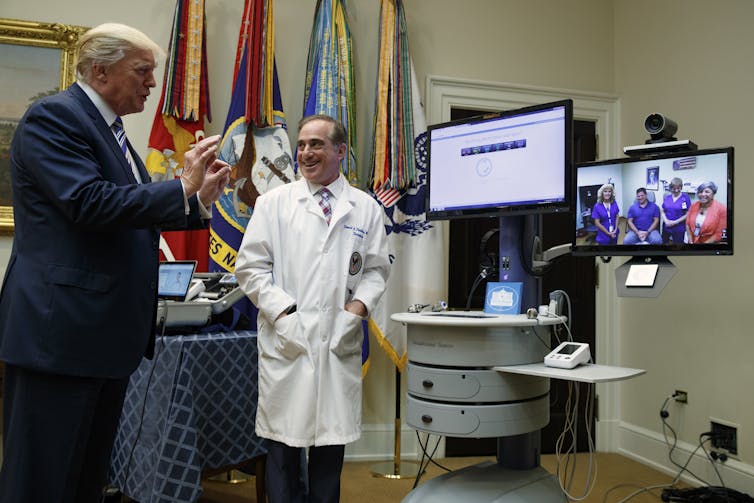Coronavirus: Telemedicine is great when you want to stay distant from your doctor, but older laws are standing in the way
- Written by Frank V. Zerunyan, Professor of the Practice of Governance, University of Southern California
As of April 1, there are more than 179,000 confirmed cases of COVID-19 in the U.S. Nowhere has been hit harder than New York City where there are more than 76,000 confirmed cases and 1,550 people have died[1]. As many had feared, the city failed to “flatten the curve” and medical need has exceeded what the health system can provide[2].
In an effort to free up critical beds and resources, all elective surgeries have been canceled[3]. Health officials are even urging people symptomatic for COVID-19 but less vulnerable – those who are generally healthy and under 60 years of age – to stay home[4] and away from emergency rooms for fear of infecting others or taking up much-needed beds.
 Samaritan’s Purse hospital in New York City is setting up emergency room field tents in Central Park.
AP Photo/Mary Altaffer[5]
Samaritan’s Purse hospital in New York City is setting up emergency room field tents in Central Park.
AP Photo/Mary Altaffer[5]
With access to in-person care extremely limited – and potentially dangerous – many hospitals have started treating and meeting patients through phone calls and over the internet.
A perfect answer to pandemic problems
I am a former member of the Medical Board of California and have been working with telemedicine regulation since 2006[6] when California Gov. Arnold Schwarzenegger appointed me to the board. After years of steady but frustratingly slow growth in telehealth across the U.S., it is exciting to see telehealth finally being utilized as an important tool to deliver care.
Telehealth, also known as telemedicine, has long been discussed as an effective way to give people access to medical professionals from the comfort of their own homes. Using a phone, a tablet or a computer, a health care provider can diagnose, treat, prescribe and educate a patient sitting miles away. In response to the coronavirus, hundreds, if not thousands, of care providers across the country have gone partially digital[7] and patients are flocking to these systems.
 Patients and medical facilities alike are turning to telehealth like never before.
Ariel Skelley/DigitalVision via Getty Images[8]
Patients and medical facilities alike are turning to telehealth like never before.
Ariel Skelley/DigitalVision via Getty Images[8]
Prior to the coronavirus, my own university hospital, Keck Medicine at the University of Southern California, used telemedicine primarily for certain cancer and dermatology patients. Over the last week, however, the USC health system encouraged and initiated more than 5,000 telemedicine appointments[9], the majority of which were not for COVID-19 symptoms. Across the country, Boston Medical Center launched a telemedicine site on March 16[10] and within 48 hours, 1,500 patients scheduled virtual visits. By using telehealth services, these hospitals are freeing up valuable resources for those who need them most while simultaneously limiting risk to those who can be treated at home.
Telehealth services can deal with a large range of problems[11] including skin issues, minor infectious diseases like the flu or cold, psychiatry and minor orthopedic problems like sprains. Physicians can also prescribe medications after a video or phone discussion.
But despite telehealth’s obvious benefits during this crisis, it is remarkably underutilized. Only a few hospital systems in the nation[12] have the technological capability to ramp up to even 50% virtual care.
And perhaps more importantly, there are unnecessary regulatory roadblocks preventing telehealth from use at a mass scale across the nation.
The fight to go digital
In the early 1990s, disparities in health care in rural counties and an aging population with greater needs prompted California to consider telemedicine[13]. The University of California at Davis launched a telemedicine program in 1992 to assist with fetal monitoring in rural counties. In 1996, California passed the first law regulating telehealth[14] which allowed only California-licensed physicians to treat residents of California through telehealth technology. Legally, to this day, a doctor from Iowa, for instance, cannot treat a person living in Los Angeles.
As laws went on the books around the country, access to telehealth remained difficult. Many states required written consent from patients before they could receive virtual care. Others required at least one in-person medical examination before telehealth appointments. Insurers refused to reimburse telehealth providers at the same rates as in-person health care visits. Reasons for refusal included the simple interpretation of a definition of a medical office visit to concerns about the quality of care. These laws were meant to protect patients, but reflected concerns of the traditional face-to-face medicine and were counterproductive to the use of this technology.
Patient advocacy groups and some state agencies – like the California Medical Board that I was a part of – saw the potential of telehealth. In the years that followed, many of the restrictive laws and regulations were removed or changed. Additionally, laws were added in many places that forced insurance companies or government-provided health coverage to pay physicians the same amount[15] for a virtual visit as an in-person visit.
For all this progress, 21 states and a few territories still do not allow the practice of medicine[16] across state lines – arguably in the interest of protecting their own licensees and the quality of care. My home state of California is one of these states, as is New York, although a bill was introduced in the state house last month to allow telehealth across state lines[17]. Particularly now, the ability for a patient in New York – where medical resources are extremely overburdened – to have a virtual appointment with a qualified physician in some place not yet as badly affected would be invaluable. Old regulation is preventing this.
 There is unprecedented support for telehealth but state laws are preventing truly widespread use.
AP Photo/Evan Vucci[18]
There is unprecedented support for telehealth but state laws are preventing truly widespread use.
AP Photo/Evan Vucci[18]
Telehealth to fight COVID-19
For the last few years momentum has been on the side of telehealth technology but utilization had still remained low. This year 91% of employers will offer telemedicine to their employees. Less than 10% of Americans[19] have ever used the technology. The coronavirus crisis has demonstrated the need unlike anything before. As health care providers have moved en masse to virtual medicine, regulators and government officials are showing unheard of support for this tool that will almost certainly save lives.
On Monday, the Federal Communications Commission announced US$200 million in funding[20] to support telehealth services across the U.S. On March 17, Medicare and Medicaid expanded the range of telehealth services that will be reimbursed[21]. And state governments[22] around the nation are requiring insurers to more broadly cover[23] telehealth appointments.
This support and interest for telehealth is unprecedented and it seems the nation has finally realized what a powerful and valuable tool telehealth can be. Harder-hit areas are literally begging doctors from other states for help[24] and if laws would allow it, telehealth could get them there instantly. Of course not all medicine can be done virtually, but a lot can, both now and in the future.
[Our newsletter explains what’s going on with the coronavirus pandemic. Subscribe now[25].]
References
- ^ 76,000 confirmed cases and 1,550 people have died (nymag.com)
- ^ medical need has exceeded what the health system can provide (www.nytimes.com)
- ^ surgeries have been canceled (www.nytimes.com)
- ^ to stay home (www.wired.com)
- ^ AP Photo/Mary Altaffer (www.apimages.com)
- ^ telemedicine regulation since 2006 (priceschool.usc.edu)
- ^ have gone partially digital (www.aamc.org)
- ^ Ariel Skelley/DigitalVision via Getty Images (www.gettyimages.com)
- ^ initiated more than 5,000 telemedicine appointments (hscnews.usc.edu)
- ^ launched a telemedicine site on March 16 (www.bostonherald.com)
- ^ large range of problems (mhealthintelligence.com)
- ^ Only a few hospital systems in the nation (www.aamc.org)
- ^ California to consider telemedicine (www.chcf.org)
- ^ law regulating telehealth (www.leginfo.ca.gov)
- ^ to pay physicians the same amount (www.natlawreview.com)
- ^ do not allow the practice of medicine (imlcc.org)
- ^ to allow telehealth across state lines (www.nysenate.gov)
- ^ AP Photo/Evan Vucci (www.apimages.com)
- ^ Less than 10% of Americans (www.fshealth.com)
- ^ US$200 million in funding (sports.yahoo.com)
- ^ that will be reimbursed (www.cms.gov)
- ^ state governments (www.msn.com)
- ^ requiring insurers to more broadly cover (www.bizjournals.com)
- ^ literally begging doctors from other states for help (www.vox.com)
- ^ Our newsletter explains what’s going on with the coronavirus pandemic. Subscribe now (theconversation.com)
Authors: Frank V. Zerunyan, Professor of the Practice of Governance, University of Southern California

